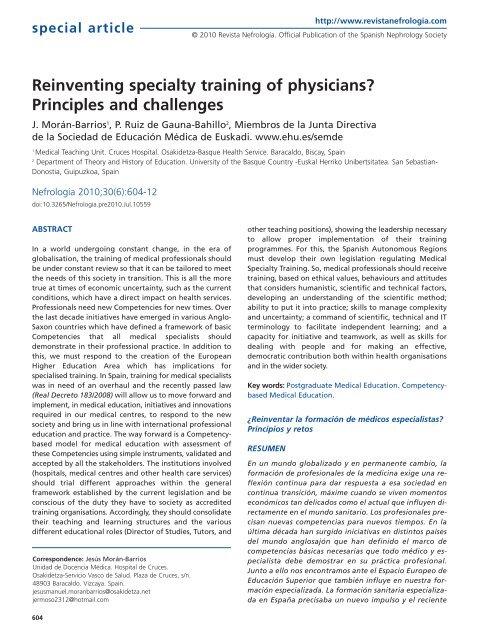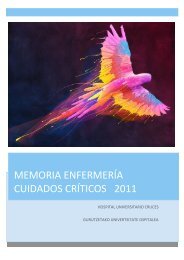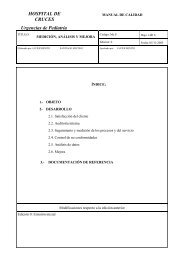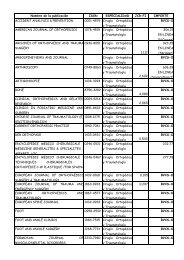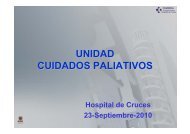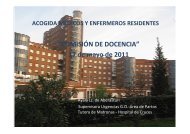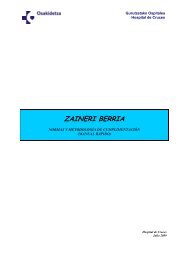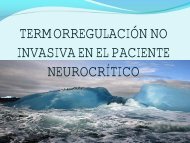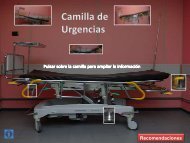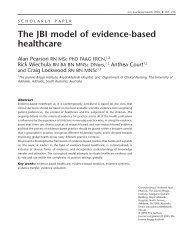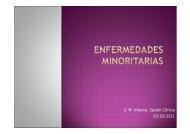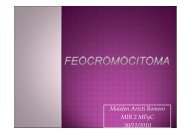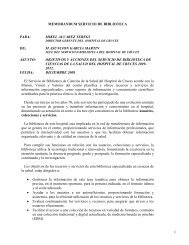special article - EXTRANET - Hospital Universitario Cruces
special article - EXTRANET - Hospital Universitario Cruces
special article - EXTRANET - Hospital Universitario Cruces
Create successful ePaper yourself
Turn your PDF publications into a flip-book with our unique Google optimized e-Paper software.
<strong>special</strong> <strong>article</strong>http://www.revistanefrologia.com© 2010 Revista Nefrología. Official Publication of the Spanish Nephrology SocietyReinventing <strong>special</strong>ty training of physicians?Principles and challengesJ. Morán-Barrios 1 , P. Ruiz de Gauna-Bahillo 2 , Miembros de la Junta Directivade la Sociedad de Educación Médica de Euskadi. www.ehu.es/semde1Medical Teaching Unit. <strong>Cruces</strong> <strong>Hospital</strong>. Osakidetza-Basque Health Service. Baracaldo, Biscay, Spain2Department of Theory and History of Education. University of the Basque Country -Euskal Herriko Unibertsitatea. San Sebastian-Donostia, Guipuzkoa, SpainNefrologia 2010;30(6):604-12doi:10.3265/Nefrologia.pre2010.Jul.10559ABSTRACTIn a world undergoing constant change, in the era ofglobalisation, the training of medical professionals shouldbe under constant review so that it can be tailored to meetthe needs of this society in transition. This is all the moretrue at times of economic uncertainty, such as the currentconditions, which have a direct impact on health services.Professionals need new Competencies for new times. Overthe last decade initiatives have emerged in various Anglo-Saxon countries which have defined a framework of basicCompetencies that all medical <strong>special</strong>ists shoulddemonstrate in their professional practice. In addition tothis, we must respond to the creation of the EuropeanHigher Education Area which has implications for<strong>special</strong>ised training. In Spain, training for medical <strong>special</strong>istswas in need of an overhaul and the recently passed law(Real Decreto 183/2008) will allow us to move forward andimplement, in medical education, initiatives and innovationsrequired in our medical centres, to respond to the newsociety and bring us in line with international professionaleducation and practice. The way forward is a Competencybasedmodel for medical education with assessment ofthese Competencies using simple instruments, validated andaccepted by all the stakeholders. The institutions involved(hospitals, medical centres and other health care services)should trial different approaches within the generalframework established by the current legislation and beconscious of the duty they have to society as accreditedtraining organisations. Accordingly, they should consolidatetheir teaching and learning structures and the variousdifferent educational roles (Director of Studies, Tutors, andCorrespondence: Jesús Morán-BarriosUnidad de Docencia Médica. <strong>Hospital</strong> de <strong>Cruces</strong>.Osakidetza-Servicio Vasco de Salud. Plaza de <strong>Cruces</strong>, s/n.48903 Baracaldo. Vizcaya. Spain.jesusmanuel.moranbarrios@osakidetza.netjermoso2312@hotmail.comother teaching positions), showing the leadership necessaryto allow proper implementation of their trainingprogrammes. For this, the Spanish Autonomous Regionsmust develop their own legislation regulating MedicalSpecialty Training. So, medical professionals should receivetraining, based on ethical values, behaviours and attitudesthat considers humanistic, scientific and technical factors,developing an understanding of the scientific method;ability to put it into practice; skills to manage complexityand uncertainty; a command of scientific, technical and ITterminology to facilitate independent learning; and acapacity for initiative and teamwork, as well as skills fordealing with people and for making an effective,democratic contribution both within health organisationsand in the wider society.Key words: Postgraduate Medical Education. CompetencybasedMedical Education.¿Reinventar la formación de médicos e<strong>special</strong>istas?Principios y retosRESUMENEn un mundo globalizado y en permanente cambio, laformación de profesionales de la medicina exige una reflexióncontinua para dar respuesta a esa sociedad encontinua transición, máxime cuando se viven momentoseconómicos tan delicados como el actual que influyen directamenteen el mundo sanitario. Los profesionales precisannuevas competencias para nuevos tiempos. En laúltima década han surgido iniciativas en distintos paísesdel mundo anglosajón que han definido el marco decompetencias básicas necesarias que todo médico y e<strong>special</strong>istadebe demostrar en su práctica profesional.Junto a ello nos encontramos ante el Espacio Europeo deEducación Superior que también influye en nuestra formacióne<strong>special</strong>izada. La formación sanitaria e<strong>special</strong>izadaen España precisaba un nuevo impulso y el reciente604
J. Morán-Barrios et al. Should we reinvent the training of physicians?<strong>special</strong> <strong>article</strong>marco regulatorio (Real Decreto 183/2008) nos permitiráavanzar y desarrollar aquellas iniciativas e innovacionesque en educación médica son imprescindibles implantaren los centros sanitarios, para responder a una nueva sociedady adecuarnos al contexto educativo y de prácticaprofesional internacional. La formación médica basadaen competencias y su evaluación con instrumentos, sencillos,validados y aceptados por todos los agentes implicadosen la formación, es el camino a seguir. Las instituciones(centros y servicios asistenciales) deberándesarrollar sus propias experiencias dentro del marco generalque proporciona la legislación vigente, y estas institucionesdeben ser conscientes del compromiso adquiridocon la sociedad a través de la acreditación docente,debiendo, por tanto, consolidar su organización docentey las distintas figuras de los agentes formadores (jefesde estudio, tutores y otras figuras docentes), ejerciendoel necesario liderazgo para el completo desarrollo de losprogramas formativos. Para ello, es preciso que las ComunidadesAutónomas desarrollen sus propias normativasen formación sanitaria e<strong>special</strong>izada. Finalmente, losprofesionales de la medicina deben tener una formaciónbasada en: valores éticos, hábitos y actitudes, que abarqueaspectos humanísticos, científicos y tecnológicos; unconocimiento y una práctica del método científico, unidosa la gestión de la complejidad y de la incertidumbre;un manejo correcto del lenguaje científico, tecnológicoe informático que facilite el aprendizaje autónomo; unacapacidad de iniciativa y trabajo en equipo, así como eldesarrollo de habilidades para los asuntos personales ypara una eficaz participación democrática en la sociedady en las instituciones sanitarias.Palabras clave: Formación sanitaria e<strong>special</strong>izada. Formaciónbasada en competencias.TRAINING OF PHYSICIANS IN AND FOR AHUMANISED AND FAIRER GLOBALISED WORLDCan we and should we continue training our residents withthe same professional profile of as little as three years ago?What new skills must we introduce and work with in trainingto make future professionals more responsible and capableof managing universal and growing healthcare demands,with limited resources; professionals who have to continueacquiring knowledge (both scientific and technical) in aglobalised world, full of uncertainty that should be movingtowards greater equality?We live in a delicate, historic time due to the major changesthat society has experienced in recent years. Our livesrevolve around problems occurring elsewhere on the planet,distant each from each other and thousands of kilometresfrom us. Just three years ago we were far less conscious ofthe impact that the decisions of others could have on ourNefrologia 2010;30(6):604-12lives, with consequences (the current economic crisis) thatare significant for our society and that will permanentlyaffect the political, sociocultural, and moral environment ofall societies. We are seeing the other side of the coin ofglobalisation; a phenomenon of economic interdependencethat has been intensely experienced since the 1990s and thathas resulted in the neoliberal politics we see today.Globalisation is taking place in the financial sector, but alsoeffects politics, science, culture, education and healthcare. 1In terms of the training of healthcare professionals of anykind we should ask ourselves: For what (world) and forwhom (people) are we doing this training? The direction thattraining institutions (universities, educational centres, andhealth centres/hospitals) should take is based on the need tohumanise society. 2 In this respect, a goal of the process oftraining professionals must be to encourage a consciousnessof universal citizenship, which will facilitate the process ofchange towards a new understanding of citizenship. Sometime ago, organisations such as the World HealthOrganisation (WHO) recommended that, within the teachingenvironment and the practice of medicine, measures must betaken to provide education aiming to achieve equitable,efficient and comprehensive care for patients, families andcommunities, according to the needs and values of theirsociety.Medical training must undergo certain changes if it is tocontribute to the amelioration of some of the deficitsresulting from globalisation. The commitment of traininginstitutions must be to enable the training of professionals byand for the community, teaching them about communityvalues of solidarity and empathy, and to be able to putthemselves in the shoes of others. This commitment must notbe on paper alone, but should manifest itself through trainingprogrammes and the actions of teachers. This commitmentshould focus on training that strengthens, among otheraspects, the bonds between different cultures, life-longlearning, autonomy and personal and professionalresponsibility, a universal vision, and, lastly, caring, creativeand critical thinking. 1 Training based around competenciesand their evaluation allows us to tackle these challenges andcommitments.THE EUROPEAN AREA AND MEDICAL TRAINING INA CHANGING SOCIETYMedical training in Spain is facing new challenges resultingfrom an important change in the educational scene inEurope: the European Higher Education Area (BolognaDeclaration of 1999 3 ). A process of convergence has begunthat has as its aim to facilitate the mobility of graduates andadapt the content of university studies to social demands. Itis an attempt to create a Europe of knowledge (a knowledgesociety, an expression coined by Peter Drucker in 1969, 4 not605
<strong>special</strong> <strong>article</strong>J. Morán-Barrios et al. Should we reinvent the training of physicians?linked to the quantity of knowledge but rather to itsproductivity, that is, its economic impact). The BolognaDeclaration states that «A Europe of Knowledge is nowwidely recognised as an irreplaceable factor for social andhuman growth and as an indispensable component toconsolidate and enrich the European citizenship, capable ofgiving its citizens the necessary competencies to face thechallenges of the new millennium, together with anawareness of shared values and belonging to a commonsocial and cultural space». 3 This does not just involve themobility students, but also of professionals with theconsequent recognition of qualifications, which implies aprofound change in medical training models both at theuniversity level as well as in <strong>special</strong>ty training. In addition,continuously changing social needs require dynamic healthsystems that must offer safe, effective, efficient, and highquality responses to the needs and expectations of citizens. 5The competency profile for health professionals should takeinto account the need for this responsiveness. Specifically,the profile must continuously be adapted and developed withnew competencies, which in turn lead to modifications inlearning and evaluation systems. This is important toguarantee, in the case of physicians, a good doctor-patientrelationship in which there is a direct influence ofdemographic, epidemiological, financial, legal, andscientific-technical changes, cultural aspects, ethics andvalues, and new models of organisation and healthcaremanagement (clinical management), as well as of the mediaand the culture of consumption. 6 Regarding these changes,A. Jovell and M. Navarro 7 highlight three social phenomena:changes in the labour structure of health professions, theappearance of a new patient/citizen model, and thetransformation and increase in the complexity of knowledgemanagement. To that, we must add the collectivisation of theprovision of health services as a strategy to guaranteeequitable access. The challenge for today’s physicians is toknow how to respond effectively and efficiently to the needsof the 21 st century and to the confidence placed in them bypatients. 5Therefore, “the simple idea that a competent professional isone who possesses the knowledge and abilities that can leadto success in a specific profession is out of date. This ideahas been replaced by the understanding that professionalcompetency is a complex phenomenon which expresses thepotential of individuals to direct their actions in the exerciseof their profession with initiative, flexibility and autonomy,in diverse scenarios, based on the integration of knowledge,skills, motives and values, and is demonstrated by efficient,ethical, and socially committed professional work. It isnecessary to eliminate fear of the unknown and join in theadventure of change from within; innovate and comprehendthe new reality; and face up to the future and understand ourrole in this reality» (Pilar Martínez Clarés). Today’s trainingof tomorrow’s <strong>special</strong>ists means providing the competencies606necessary to confront the uncertainties of future clinicalpractice, and appropriately manage future changes in societyand within the medical profession itself (the areas of<strong>special</strong>isation and collaboration between them, for example),as well as identifying and understanding the role of thephysician among the various stakeholders that influence theprofession of medicine (the state/governments, healthorganisations/corporations, the health technology andpharmaceutical industry, citizens and other healthprofessionals 8,9 ).It is within this context of ever greater and more complextransformations that competency-based training (CBT)emerges to enable the better adaptation and development ofindividuals, 10 in this case, physicians. CBT focuses onlearning and not on teaching, and on reaching specificobjectives, i.e., on the results of learning, integratingknowledge and knowing how to do, be and act. 11THE RESIDENCY SYSTEM (SPECIALISED HEALTHTRAINING), NEW CHALLENGES ANDOPPORTUNITIESTraining medical <strong>special</strong>ists involves the gradual integrationof recent graduates in medicine into the care activities of ahealth centre or hospital with growing responsibility anddecreasing supervision over time. Is it possible to carry outthis professional training without having the tools andresources necessary to guarantee that this integration isappropriately planned and supervised, and that the finalresult (a competent medical <strong>special</strong>ist) is the consequence ofcompleting a programme designed to meet current healthcaredemands? 12The Spanish system for medical graduate training, known asthe MIR, was born in the 1960s as a result of the “Seminariode <strong>Hospital</strong>es” (a meeting bringing together representativesof major hospitals from across Spain: <strong>Hospital</strong> de la SantaCreu i Sant Pau, Clínica Puerta de Hierro, <strong>Hospital</strong> Marquésde Valdecilla, Fundación Jiménez Díaz, <strong>Hospital</strong> de Basurto,and <strong>Hospital</strong> General de Asturias ). 13 It is based on learningon-the-job and has been one of the most important drivers ofthe modernisation of medical practice in Spain. The system,as regulated in 1984, has a strong state structure controlledfrom the Spanish Ministry of Health and Social Policy. 14 Thefollowing characteristics of the system should behighlighted: the accreditation of healthcare centres andteaching units (clinical departments), whose guarantee ofquality training is monitored through regular audits; auniversal entrance exam; and the definition and classificationof <strong>special</strong>ties and associated programmes, as regulated bythe corresponding National Specialty Commissions and aNational Council. However, there are considerableweaknesses in the way in which the system is put intopractice within healthcare institutions. The Order onNefrologia 2010;30(6):604-12
J. Morán-Barrios et al. Should we reinvent the training of physicians?<strong>special</strong> <strong>article</strong>Teaching Commissions of 1995, 15 which regulates theirpowers and operation, as well as those of the directors ofstudies and tutors (educational supervisors), has not beenthoroughly implemented and the evaluation system itproposed, the one currently operating, is more a system ofcertification of completion of a series of rotations orplacements in certain care units, than a true training andassessment of competencies. A study by the NationalCommission on Nephrology revealed some of theseweaknesses in the training of <strong>special</strong>ists, from irregularallocation of human and material resources within teachingunits, to failures to fulfil teaching objectives and the role ofmentoring (tutor), run on a voluntary basis, being littlerecognised. 16 With the new law, Real Decreto 183/2008, 17 theentire National Health System has had a great opportunity todevelop and improve the system for <strong>special</strong>ised medicaltraining, providing the framework for competency trainingand assessment, addressing, among other points, thechallenges of multi-professional units, and a controversialbut fundamental issue, the core curriculum. You must first bea doctor and only then a <strong>special</strong>ist.However, as noted by J. Cobo-Reinoso, the mere passing oflegislation does not guarantee its successfulimplementation; 18 this author highlights the elements thatshould comprise a residency programme for it to be botheffective: 1) the definition of a training programmeconsistent with training objectives; 2) establishment ofmonitoring protocols; 3) adequate communication withtutors; 4) a comprehensive assessment system, essentiallyeducational, and more demanding; and 5) quality control bythe Teaching Commission. This is not possible withoutfunding and a definitive consolidation of healthcareorganisations, educational structures and training agents(directors of studies, tutors, trainers and other teaching staff),and, in Spain, this is the responsibility of the regionalgovernments.PROFESSIONAL COMPETENCIESM.O. Bunk defines competence as behaviour resultingfrom a set of attitudes, skills, abilities, knowledge andvalues that people use to deal with specific situationsrelated to their life and profession. 19 It is, in short, theeffective ability to successfully carry out a clearlyspecified work activity. Professional competence is not ameasure of the probability of success in the execution of aprofession; it is a real and demonstrated ability that can beevaluated based on results.The start of the competency movement can be traced back toa paper published in 1973 by David McClelland, whoasserted that not only aspects such as knowledge and skills,but also feelings, beliefs, attitudes and behaviours canpredict high work performance. 20 We are referring toNefrologia 2010;30(6):604-12empathy, intuition, integrity, perception of reality, the spiritof community, self-confidence, flexibility, and the domain ofthe individual. These concepts are fully applicable to theworld of healthcare and indeed are today recognised asbeing fundamental aspects of the competencies of a medicalpractitioner. A Gual et al 9 agree with this, stating that for thefuture we require: physicians who adopt a critical approach,who are communicative and empathetic, individually andsocially responsible, make decisions which are good for thepatient and the health care system, leaders of the healthteam, competent, effective and safe, honest and reliable,committed to patients and the organisation; physicians whotreat patients, not diseases. In summary, the competencies ofa professional combine knowledge (Know), skills andabilities (know-how), attitudes and behaviours (how to act),and values and beliefs (how to be).Faced with the aforementioned changes and challenges ofthe 21 st century, academic and health organisations invarious countries began to define basic competencies forphysicians in the 1990s and early 2000s including:Tomorrow’s Doctor 21 and Scottish Doctor 22 (UK),CanMEDS Roles 23,24 (Canada), the Outcome Project of theAccreditation Council for Graduate Medical Education 25,26(USA) and the Institute for International MedicalEducation (IIME) in New York 27 (Table 1). Thecompetency domains defined in these models areperfectly applicable to any <strong>special</strong>ty. Specifically,CanMEDS and the Outcome Project define what allresidents must demonstrate upon completing theirtraining. Along these lines, in 2008 the Medical TeachingUnit at <strong>Cruces</strong> <strong>Hospital</strong> (in its Competency-basedPostgraduate Medical Education [CBPME] project, whichstarted in 2004) 28 defined its model of «Being aPhysician/Medical Professional» (Teaching Vision 29 ) forall <strong>special</strong>ties of the centre, based on the model of theIIME, and incorporating concepts from the OutcomeProject, CanMEDS and the American Board of MedicalSpecialties. 30 Table 2 summarises the model «Being aPhysician/Medical Professional at <strong>Cruces</strong> <strong>Hospital</strong>»,which is to be the foundation of our competencyevaluation system.These approaches do not mean that doctors, to date, have notbeen trained in such competencies; the difference is that inthe CBPME project they are made explicit, and thosecompetencies necessary to address changing social andhealthcare needs are emphasised. 31 Working with such amodel facilitates the development and adaptation of thelearning process (learning objectives derived from thecompetencies, activities, specific tasks, training plans,schedules, methodologies and teaching resources) and theimplementation of a final competency assessment (outcomebasedassessment). To bring about the changes required, it isvery important that all professionals adopt the sameapproach and language, a task that will take time.607
<strong>special</strong> <strong>article</strong>J. Morán-Barrios et al. Should we reinvent the training of physicians?Table 1. Model of competency domainsCanMEDsOutcome Project (ACGME)IIEM New YorkBeing a Physician/Professional at<strong>Hospital</strong> de <strong>Cruces</strong>1. Expert Physician2. Communicator1. Professionalism2. Interpersonal and1. Professional values, attitudes,behaviour and ethics1. Professionalism: professionalvalues, attitudes, behaviour andethics3. Collaborator4. Manager5. Health advisor6. Scholar7. ProfessionalCommunication Skills3. Medical Knowledge4. Patient Care5. Practice based on the HealthSystem context6. Clinical practice based onlearning and improvement a2. Communication skills3. Scientific fundamentals ofmedicine4. Clinical skills5. Public health, health systems6. Information management7. Critical analysis, self-training andresearch2. Clinical skills (clinical patient careexpert)3. Communication4. Scientific fundamentals of medicine(knowledge)5. Public health, health systems(health promoter, manager ofresources)6. Critical analysis and research.Self-training7. Information managementaThe competency domain of the ACGME model: “Professional practice based on learning and improvement” is broken down into two parts, in the IIEMmodel: “Critical analysis, self-training and research” and “Information management”.THE EDUCATIONAL PROCESS IN THE CONTEXT OFTHE WORKPLACE AND THE ROLE OF INSTITUTIONSIN PROFESSIONALISATIONTraining in the workplace professionalises the residentby developing their understanding of the knowledge,skills, abilities, attitudes and values that are present,these days, in the medical profession. However, it canalso de-professionalise, as it is difficult to implementeducational practices in each and every care setting inwhich residents train. The workload and other factorsassociated with healthcare organisations and theirTable 2. Physicians/Professionals at <strong>Cruces</strong> <strong>Hospital</strong> (2008)Summary of the basic concepts of each competency domain. All residents will have and be able to demonstrate:1. PROFESSIONAL ATTITUDES/VALUES (PROFESSIONALISM): Show integrity, accept responsibility, and complete tasks. Work within the limits of theirabilities; ask for help when needed. Show respect and interest in the patients and their families. Be punctual and comply with work schedule.2. PATIENT CARE AND CLINICAL SKILLS: Obtain a medical history and complete physical examination; request diagnostic tests as necessary andintegrate the information to carry out a correct differential diagnosis. Create an appropriate treatment plan. Show skills in the performance oftechnical procedures for their level.3. COMMUNICATION: Communicate effectively with patients and families, with other members of the work team and with the rest of the healthcarestaff.4. MEDICAL KNOWLEDGE: Keep their clinical knowledge up to date. Ask pertinent questions. Use their knowledge and analytical thinking to solveclinical problems. Demonstrate appropriate clinical judgment.5. PRACTICE BASED IN THE HEALTH SYSTEM CONTEXT (PUBLIC HEALTH AND HEALTH SYSTEM): Make rational use of health resources. Work toguarantee patient safety and identify the reasons for errors; follow clinical practice guidelines (protocols).6. PRACTICE BASED ON CONTINUOUS LEARNING AND IMPROVEMENT (CRITICAL ANALYSIS, SELF-TRAINING): Critically assess scientific literature anduse available scientific evidence for patient care. Self-evaluate their clinical practice and change behaviour. Facilitate and collaborate in the learningof colleagues.7. INFORMATION MANAGEMENT: Find, interpret, and appropriately apply clinical and scientific information.608Nefrologia 2010;30(6):604-12
J. Morán-Barrios et al. Should we reinvent the training of physicians?<strong>special</strong> <strong>article</strong>management do not facilitate interaction between tutorsand residents. Though the residents should not forgetthat they are primarily responsible for their own trainingand must be proactive, this climate occasionally leadstutors and staff to forget their teaching role and that theresidents are professionals in training. Institutions mustguarantee: 1) the exercise of leadership from senior andmiddle management (directors of studies, heads ofdepartment, tutors); 2) the planning and development ofa teaching strategy, with the involvement of all relevantparties (tutors and staff), facilitating decision-makingand accountability, including on the part of residents; 3)the resources (structural, material, financial andorganisational); 4) the development of programmesintegrated into the care system in accordance with adefined profile of medical <strong>special</strong>ist; and 5) thequalitative and quantitative measurement of results. It iswithin this scheme that the tutor is essential as amanager of a programme of <strong>special</strong>isation within theteaching strategy of the centre. Duties and training tasksshould be specified in the training programme contractsof the centres and in the portfolio of services of teachingunits. This is a reflection of the duty they have to societyas accredited teaching institutions. 12Therefore, the objective is to provide a professionalwith: 1) broad and essential training, based on ethicalvalues, behaviours and attitudes and that encompasseshumanistic, scientific and technical aspects; 2) anunderstanding of the scientific method and ability to putit into practice, and to manage complexity anduncertainty; 3) a command of scientific language andskills enabling the proper use of computer technology, tofacilitate independent learning; and 4) sufficientexperience in the field of interpersonal relations toencourage initiative and teamwork, and the developmentof skills for personal relations and for effectivedemocratic participation in society. 32 To achieve thisgoal, healthcare centres and teaching units (clinicaldepartments) should be aware that there must beconsistency in the training process, taking into accountthe three stages of the teaching/learning cycle: before,during and after. Before provides for the socialenvironment of the <strong>special</strong>ty, the skills to be developedby level, the role of the tutor, the resident, the othertrainers and the institution. During (interaction) includestraining contexts, how learning will be enhanced in eachof the contexts; specific, joint and individual tasks;methodological strategies; and ongoing or formativeevaluation. After, involves evaluation of the learning ofthe resident, tutor performance, the development of thetraining process, the programme, the trainers and otheragents of the support structure. 32 The tutor, as the pivotalfigure in this complex process, with a high level ofsocial responsibility, must acquire and develop certainteaching competencies. 33Nefrologia 2010;30(6):604-12EVALUATION WITHIN THE TRAINING PROCESSConcepts and general principlesRigorous and transferable evaluation is the great unmetchallenge in the <strong>special</strong>ised training system, and it willnever be possible if all training agents (not just the tutors)are not sure what to evaluate, i.e., if there is not a clearlydefined programme with competencies to be achieved 34 (aprofessional profile, of the nephrologist in our case) andwith instruments accepted throughout the institution. Theevaluation (the after) is a moral obligation to society, theinstitution, and the resident (it is their right, for thepurpose of guiding and supporting them in their learning,and in the acquisition and improvement of theircompetencies). Evaluation forms part of a complextraining process and should be well defined a priori.Indeed, it is also a process in itself that generates datathrough assessment applying reference criteria, and thisinformation is used to make judgments and decisions.These decisions can take many forms, but can becategorised under two broad types: a qualifying decision,a sanction, pass/fail, with no possibility of rectification,except by undergoing a new evaluation process (this typeis called a summative assessment) and another type whichcan use the same instruments but is based on results. Thislatter type of evaluation allows the candidate tounderstand their strengths and weaknesses and createplans for improvement (it is known as formativeassessment). Both demand an equal degree of rigor intheir procedure and documentation. In the current trainingsystem, we must move away from the ingrained culturalconcept of “pass/fail”, and thoroughly develop formativeassessment. It should be realised that an evaluationprocess tends to fail if the following questions have notbeen clearly answered beforehand: 34 Which competenciesare to be evaluated?. How? (with what instruments?).Why evaluate? (what is the objective?). When? Bywhom? With what resources?, and is there collaborationacross the entire team?. Therefore, every evaluationshould conform to the following principles: 35 it should be;1) appropriate to the purpose (why?); 2) based on theprogram content (what?); 3) use methods selected interms of validity, reliability and feasibility (based on thebest available evidence); 4) have standardised, transparentand public documentation and methods; 5) provideimportant and positive feedback (educational evaluation);6) be overseen by evaluators with demonstrated abilityand willingness to collaborate (who?); 7) allow for laypeople to assess or examine areas in which they arecompetent (e.g., communication, professionalism); 8)receive sufficient resources, and 9) have a comprehensivesystem of quality assurance. The evaluation should not belimited to the resident but rather must embrace theprogramme, process, structure and training agents, as thekey to improvement.609
<strong>special</strong> <strong>article</strong>J. Morán-Barrios et al. Should we reinvent the training of physicians?What to evaluate and how to assess thecompetencies of a professionalEvaluation of residents has, as its objective, to improve andfacilitate the development of knowledge, skills, abilities,attitudes and values. To achieve this objective will requireongoing assessment of the resident in their acquisition ofknowledge, skills and attitudes, and monitoring of thesuccesses or failures of the design and operation of the trainingprogrammes. The assessment of professional competenceinvolves various dimensions that are reflected in actions: 22 1)what the doctor is able to do: technical intelligences (clinicalcompetencies and skills), 2) how the doctor approaches theirpractice: intellectual (basic knowledge), emotional (attitude),the creative and analytical (reasoning) intelligences, and 3) thedoctor as a professional: personal intelligences (values, ethics,professionalism). There are many validated tools and methodsto assess each of these areas, which when combined, allow usto judge the competence of a professional. A description ofthese and their application is beyond the scope of this <strong>article</strong>,and there are excellent reviews on the subject. 36,37 A particularlyuseful document is the Toolbox (Outcome Project, ACGME 38 ),which describes each instrument well, its underlying concept,psychometric qualities, utility, validity and reliability. Based onthat document and grouping competencies into seven domains,as described in Table 2, the potential assessment tools for eachdomain would be:1. Professional values, attitudes, behaviour and ethics:Multiple source feedback (MSF), 39 commonly used in theprivate sector, patient point of view, and objectivestructured clinical examination (OSCE). 402. Clinical skills (clinical healthcare expert): standardisedpatients, simulations, OSCE, clinical evaluation by directobservation of clinical practice in the workplace (Mini-CEX - Mini-Clinical Evaluation Exercise, DOPs -Directly Observed Procedural Skills 41,42 ), questionnaires,case studies, clinical records, audits, peer reviews,quality indicators, reports, and portfolios. 43 In relation tothis, <strong>Cruces</strong> <strong>Hospital</strong> is developing its own model ofreflective logbook/report to form the basis of futureportfolios. 44,45 Note, however, in terms of the clinicalevaluation tests by direct observation, they have beendeveloped in the Anglo-Saxon world to deal with aconcern that Norcini highlights in his <strong>article</strong>, 41 that thetrainees are seldom observed, so the circumstances in ourenvironment may be different.3. Scientific foundations of medicine (medical knowledge):testing all types of knowledge, multiple-choice questions(MCQs), extended-matching items (EMIs), 46 structuredcases, simulations and models.4. Communication: patient opinions, MSF, standardisedpatients, and OSCE.6105. Public health systems (health promoter and manager ofresources): MSF, questionnaires, and patient opinions.6. Information management: computer simulations, andcases.7. Critical analysis and research, and self-directedlearning: portfolios, reflective reports, and standardisedcases.To evaluate the competencies of a professional manydimensions must be considered, it being necessary toextrapolate from partial data to arrive at a complete picture.Nevertheless, we should start with very simple, inexpensiveinstruments, accepted and understood by all clinical staff andthe resident, and that provide added value to ourPostgraduate Medical Education system.CONCLUSIONSpecialised training based on competencies is the answer toa globalised world in permanent change. To take thisforward, medical centres and services should develop theirown projects, as allowed for within the existing regulatoryframework. Health institutions should be aware of their dutyto society given their accreditation as teaching bodies.However, if they are to exert effective leadership in thedevelopment of training programmes it is essential thatstructural, organisational and human resources are madeavailable. In Spain, this is already provided for in currentlegislation, and the regional governments are responsible forimplementing and developing this infrastructure withoutfurther delay.AcknowledgementsAcknowledgements to Pilar Martínez Clarés, Professor in the Departmentof Diagnostic and Research Methods applied to Education, Facultyof Education (University of Murcia) for her personal contribution to thecontent of this text, to the Tutors of the Competency Assessment Group(Andima Basterretxea, Elena Bereziartua, Milagros Iriberri and AgustínMartínez-Berriochoa) and to Mª Jesús González-García, secretary of theMedical Teaching Unit at <strong>Cruces</strong> <strong>Hospital</strong>.REFERENCES1. Ruiz de Gauna P. La formación médica en una sociedad globalizada.In: Fonseca M, Ruiz de Gauna P (eds.). Avances en EducaciónMédica: Retos presentes para futuros profesionales de las cienciasde la salud. Oral presentation at the I SEMDE Congress, 22-25 June2004. Bilbao: Basque Society for Medical Education (SEMDE),2005;2:21.http://www.ehu.es/SEMDE/archivos_pdf/avances_ed_medica.pdf2. Mardones JM. Educar para una sociedad más humana: la educaciónNefrologia 2010;30(6):604-12
J. Morán-Barrios et al. Should we reinvent the training of physicians?<strong>special</strong> <strong>article</strong>ante la economía y la cultura. Retos educativos para la próxima décadaen la Unión Europea y sus implicaciones organizativas: VII InteruniversityCongress on the Organisation of Educational Institutions(VII CIOIE). San Sebastián, 4-6 July 2002;81-96.3. The Bologna Declaration of 19 June 1999. http:// www.bologna-bergen2005.no/Docs/00-Main_doc/990719BOLOGNA_DECLARA-TION.PDF4. Stein G. Peter Drucker (I). Hacia una biografía intelectual. In: InstitutoEmpresa y Humanismo (Cuadernos Empresa y Humanismo n.º73). http://www.unav.es/empresayhumanismo/publicaciones/cuadernos/catalogo07.htm5. White Paper on the Health Care Professions in Catalonia (Libro Blancode las profesiones sanitarias de Cataluña). Department of Healthand Social Security of the Catalan Regional Government B-18.688-2003; p. 69.6. Jovell A. El futuro de la profesión médica. Josep Laporte LibraryFoundation, 2001. http://www.fbjoseplaporte.org/docs/repositori/070517121543.pdf7. Jovell A, Navarro M. La profesión médica en la encrucijada: hacia unnuevo modelo de gobierno corporativo y contrato social (2006).http://www.fbjoseplaporte.org/docs/repositori/070727130419.pdf8. Ser Médico, hoy. Retos del nuevo profesionalismo médico en España.Report of the Medical Education Foundation (FEM) for the GeneralCouncil of the Colleges of Physicians (CGCOM) . Madrid 2006http://www.educacionmedica.net/sec/serMedico 2006.pdf9. Gual A, Oriol-Bosch A, Pardell H. El Médico del futuro (Physician forthe future). Med Clin (Barc) 2010;134:363-8.10. Martínez-Clares P, Martínez-Juarez M, Muñoz-Cantero JM. Formaciónbasada en competencias en educación sanitaria: aproximacionesa enfoques y modelos de competencia. RELIEVE 2008;14(2):1-23. http://www.uv.es/RELIEVE11. Echeverría B. Gestión de la competencia de Acción Profesional. Revistade Investigación Educativa 2002;20(1):7-43.12. Morán Barrios J. ¿Es necesaria y compatible la existencia del tutorde médicos residentes dentro de nuestras estructuras asistenciales?Educ Med 2003;6(3):10-1.13. Sistema Español de Formación E<strong>special</strong>izada. Evolución, Situaciónactual y Perspectivas de futuro (ref 713/000155). In: Meeting of theCommittee for Health and Social Security on 30 June 1992, OfficialRecord of the Spanish Senate: commission no. 190,1992.14. Real Decreto 127/1984, of 11 January, regulating <strong>special</strong>ised medicaltraining and the recognition of medical <strong>special</strong>ist. (in effect until22 February 2008). BOE no. 26 of 31/1/1984;2524-8.15. Orden de 22 June 1995 regulating the Teaching Committees (Comisionesde Docencia) and systems of evaluation used in the trainingof medical and pharmaceutical <strong>special</strong>ists.http://www.boe.es/boe/dias/1995/06/30/pdfs/A19793-19799.pdf16. Quereda C, on behalf of the Spanish National Commission for theSpecialty of Nephrology (Ortega F, Martín de Francisco A. L., MatesanzR, Alcázar R, Sanz Boix A, Bernis C, Abaigar P, Sánchez CasajúsA, Mérida E, García Pérez MA). Algunos aspectos de la situaciónde la formación de e<strong>special</strong>istas de Nefrología en España. Nefrologia2008;28(3):263-271.17. Real Decreto 183/2008, of 8 February, identifying and classifying<strong>special</strong>ties in the Health Sciences and specifying certain characteristicsof the system for <strong>special</strong>ist health training.Nefrologia 2010;30(6):604-12http://www.msc.es/profesionales/formacion/docs/realDecreto183_2008.pdf18. Cobo-Reinoso J. La difícil transición de licenciado a e<strong>special</strong>ista.Educ Med 2009;12(Supl 3):S45-S50.19. Bunk GP. Teaching Competence in Initial and Continuing VocationalTraining in the Federal Republic of Germany. Vocat Train Eur J1994;1:8-14.20. McClelland D. Testing for Competence rather than for Intelligence.Am Psychol 1973;28(1):1-14.21. Tomorrow´s Doctor. http://www.gmc-uk.org/education/undergraduate/tomorrows_doctors.asp22. The Scottish Doctor Project 2000. http://www.scottishdoctor.org/resources/scotdoc1.pdf23. CanMEDS 2000 Project: Extract from the Societal Needs WorkingGroup Report. Medical Teacher 2000;22(6):549-54, and the Can-MEDS 2005 Framework. http://rcpsc.medical.org/canmeds/bestpractices/framework_e.pdf24. Frank JR, Danoff D. The CanMEDS initiative: implementing an outcomes-basedframework of physician competencies. Medical Teacher2007;29(7):642-7.25. An Introduction to Competency-based Residency Education. ©2006ACGME. A product of the ACGME Outcome Project, 2006;http://www.acgme.org/outcome/comp/compCPRL.asp26. Swing SR. The ACGME outcome Project: retrospective and prospective.Medical Teacher 2007;29:648-54.27. Institute for International Medical Education, Core Committee. GlobalMinimum Essential Requirements in Medical Education. MedicalTeacher 2002;24:130-5.28. Morán Barrios J. Competencia profesional de médicos e<strong>special</strong>istasy modelo de gestión de la formación médica e<strong>special</strong>izada basadoen la experiencia del <strong>Hospital</strong> de <strong>Cruces</strong>. In: Fonseca M, Ruiz deGauna P (eds.). Avances en Educación Médica: Retos presentes parafuturos profesionales de las ciencias de la salud. Oral presentationat the I SEMDE Congress, 22-25 June 2004. Bilbao: Basque Societyfor Medical Education (SEMDE), 2005;9:83.http://www.ehu.es/SEMDE/archivos_pdf/avances_ed_medica.pdf29. Morán Barrios J. Ser Médico. http://www.hospitalcruces.com/documentos/actividadDocente/VISION_DOCENTE-SER_MEDICO.pdf30. American Board Medical Specialties. MOC Competencies and Criteria:http://www.abms.org/Maintenance_of_Certification/ABMS_MOC.aspx31. Morán Barrios J. La Formación basada en competencias debe de introducirsetambién en la Formación E<strong>special</strong>izada (interview). DPM2010;3(1):37-40. http://www.idepro.es/dpm/v3_n1/DPM3_1.pdf32. Fonseca M, Ruiz de Gauna P. Formación médica e<strong>special</strong>izada: formaren competencias para incidir en el perfil del professional quenecesita la sociedad y la sanidad del siglo XXI. In: Perspectivas parael Cambio en la Formación y la Práctica Médica, pp. 67-71. Bilbao,26-27 October 2006: II Congress of the Basque Society for MedicalEducation (SEMDE). http://www.ehu.es/SEMDE/publi.htm33. Saura Llamas J. Cómo puede convertirse un tutor en un docenteefectivo. Aten Primaria 2007;39(3):151-5.34. Morán Barrios J. Estrategias e instrumentos de evaluación del residente.Valladolid, 8 and 9 October 2008: Oral presentation at a Meetingof Tutors in Specialised Health Training in de Castilla y León.http://www.ehu.es/SEMDE/publi.htm611
<strong>special</strong> <strong>article</strong>J. Morán-Barrios et al. Should we reinvent the training of physicians?35. A working paper from the Postgraduate Medical Education Training Board.Principles for an assessment system for postgraduate medical training,14 September 2004. http://www.ecompendium.nhs.uk/PMETBprinciples-forassessment-systems.asp36. Epstein RM. Assessment in Medical Education. N Engl J Med2007;356:387-96.37. Wass V, Van der Vleuten C, Shatzer J, Jones R. Assessment of clinicalcompetence. Lancet 2001;357:945-9.38. ACGME Outcome project. Toolbox of assessment methods:http://www.acgme.org/Outcome/assess/Toolbox.pdf39. Whitehouse A, Hassell A, Bullock A, Wood L, Wall D. 360 degreeassessment (multisource feedback) of UK trainee doctors: Field testingof team assessment of behaviours (TAB). Medical Teacher2007;29(2- 3):171-6.40. Martínez Carretero JM. Los métodos de evaluación de la competenciaprofesional: la evaluación clínica objetiva estructurada (ECOE).Educ Med 2005;8(Supl 2):S18-S22.41. Norcini J, Burch V. Workplace-based assessment as an educationaltool: AMEE Guide No. 31. Medical Teacher 2007;29(9-10):855-71.42. Norcini J. The Mini Clinical Evaluation Exercise (mini-CEX). ClinicalTeacher 2005;2(1):25-30.43. Snadden D, Thomas M. The use of portfolio learning in medical education.Medical Teacher 1998;20(3):192-9.44. Morán J, Fernández F, Lorenzo M, Sharluyan A. Memoria de Formacióndel Médico Residente (MFMIR). Aproximación al portafolio docente.Educ Med 2005;8(3):159. (I-8).45. Morán J, Carballo G, Ruiz de Gauna P. Contenido reflexivo de la memoriade formación MIR del <strong>Hospital</strong> de <strong>Cruces</strong>. Bases del portafolioformativo. Educ Med 2007;10(3):169. D-6.46. Case SM, Swanson DB. Extended-matching items: A practical alternativeto free-response questions. Teaching and Learning in Medicine1993;5(2):107-15.Sent for Review: 22 Jun 2010 | Accepted: 22 Jul. 2010612Nefrologia 2010;30(6):604-12


